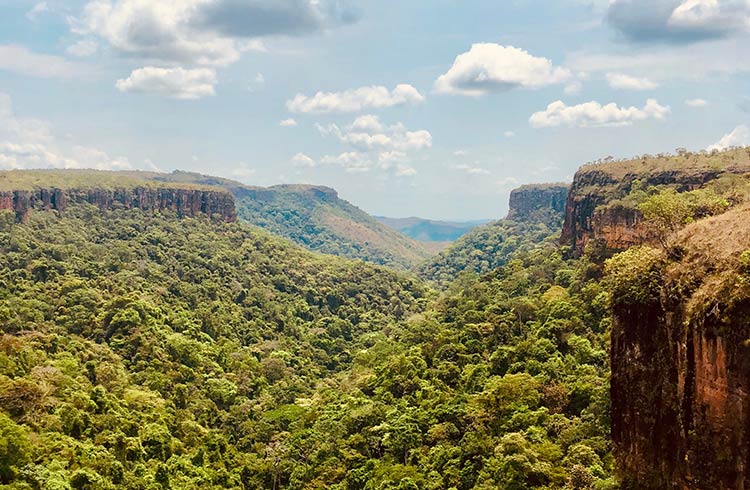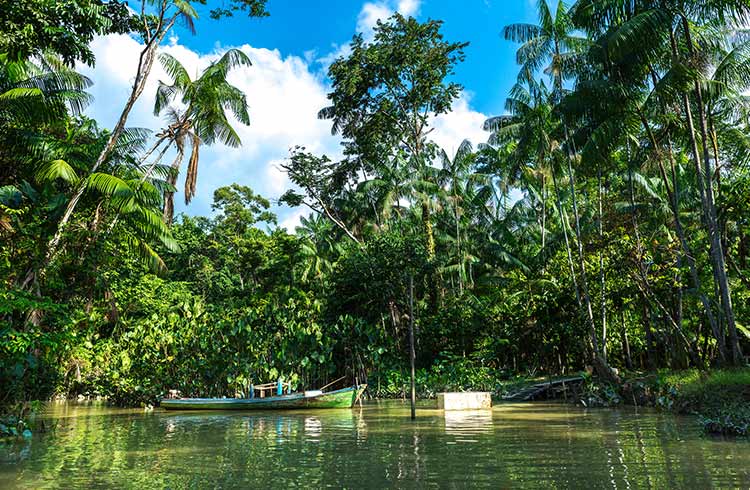6 Essential Adventure Travel Safety Tips for Brazil
Brazil is the perfect place to get back to nature. Find out how to experience Brazil's wild destinations safely.
 Photo © Photo by Joao Tzanno on Unsplash
Photo © Photo by Joao Tzanno on Unsplash
- Iguazu Falls Travel Tips
- Discover Chapada Diamantia
- Stay Safe in Manaus Before the Adventure Begins
- Wildlife Safety in Brazil
- The Realities of a River Boat Trip
- River Trip Tips
Iguazu Falls Travel Tips
The magnificent Iguazu Falls (Foz du Iguazu) are one of Brazil's big scenic drawcards. The site of the falls is split between Brazil, Argentina and Paraguay.
Many visitors, having invested the time and money to reach the falls, spend a full day on each of the Brazilian and Argentinian sides, and it's relatively easy to move through the borders here.
You may require a visa to enter Brazil, but the immigration officials at Iguazu have been known to be a little lenient if you're just planning a day trip into the country. Don't expect to be welcomed into Brazil from the Argentinian side without a visa, plan ahead.
Frequent shuttle buses between each side of the falls and the border make the whole process a little easier but have led to problems for a few travelers. The buses will stop to let you off at the border, but generally will continue on while you go through immigration, leaving you to catch the next bus onward. It might seem like a hassle but take all your belongings with you through customs.
Remember to take out some cash before heading to the national park, as you have to pay entry to the national park and will need to pay extra again if you want to take a boat trip under the falls, which is an incredible experience.
Pack a raincoat, poncho or wear quick-dry clothing, because you will get soaked. Even if you don't take a boat trip, the fine mist thrown up by the churning water will wash over you as soon as you get below the edge of the falls. Be aware your camera might get wet, so keep it covered if it is not waterproof.
Visiting outside peak season (January and February) might make for a more serene experience, but it can get quite cold in southern Brazil. This chill will only be exacerbated by the cold spray from the waterfalls, so if you're visiting between May and August, remember to take some dry clothes to change into.
Discover Chapada Diamantina
One of Brazil's most impressive national parks, Chapada Diamantina, is often off travelers radars. Countless waterfalls spill through unusual rock formations into crystal clear swimming holes that in turn lead to inviting underwater caves. With views over vibrant valleys and a wealth of stunning wildlife it is like a lost world, perfect for hikers, cavers and divers alike.
The spectacular Cachoeira da Fumaca (Smoke Falls) are so high that the water vaporizes and twists away on the wind before reaching the ground. Plus there's always the hope of finding one of the diamonds that brought this place to prominence.
There are many sights accessible by car or a short hike from the central town of Lencois, or you can arrange to go by bike, canoe, mule or horse. But if you'd like to venture a little further afield a local guide is recommended. Maps of the park and some of the signage can be a little confusing and unreliable. A local will not only reveal the most impressive spots, but they'll make sure you don't stumble into one of the park's many crevices or cave systems. If you do want to go a little deeper and explore these caverns an expert guide is a must. They'll provide the necessary equipment but more importantly, they'll make sure you find your way back to the brilliant Brazilian sun.
Stay Safe in Manaus Before the Adventure Begins
Manaus is the jumping-off point for many people's Amazon adventures. Despite being deeply nestled in impenetrable jungle, this large city thrives on the lifeline of the river.
The oppressive heat and humidity mean things move a little slower here but there are still some very quick fingers. Manaus is notorious for pickpockets and the crowded river ferries brim with light-fingered thieves. Keep your valuables concealed and closely guarded. A decoy wallet with a couple of notes is also a good idea.
As soon as you arrive in Manaus you're likely to be approached by all sorts of hawkers promising life-changing tours. These guys collect a finder's fee from the agency they deliver you to so they'll just dump you into whichever place pays the most. The good tour companies have well-earned reputations and will come recommended by locals and travelers, so there's no reason to rely on these touts.
If you're not wild about any of the standard package tours on offer, don't be afraid to ask for a different format, especially if you're with a group. Not everyone will be accommodating but you should be able to find a decent guide who'll adapt to your desire, whether you want to just float on the river for a few days or build your own raft and hut in a Spartan survival challenge.
Wildlife Safety in Brazil
Whatever the format of your trip in the Amazon, don't expect to see leopards leaping after toucans from tree to tree, while anacondas wrestle alligators below. The Amazon jungle is very dense, and most animals will hear you crashing through the undergrowth from miles away, giving them plenty of time to scurry away.
Even if you're drifting silently in a canoe you'll have to be content with whatever life gathers at the riverbank. The best way to appreciate the teeming life of the Amazon is not to see it, but to spend a night just listening to the sounds of the animals in the jungle.
If you do see wildlife, always take advice from the guides. Never try to touch wild animals, never feed the wildlife, and keep a safe distance at all times. Human interaction with non-domesticated animals is never a good idea. If your guide suggests you get closer, don't be tempted to do so. Instead, bring a camera that has a good zoom lens.
The Realities of a River Boat Trip
One increasingly popular journey in the Amazon is to hop on board a big, crowded riverboat that chugs up and down the Amazon and Rio Negro, either towards the coast or the meeting point with Colombia and Peru at Tabatinga.
This is a great way to discover and learn about the societal scope of the Amazon, but isn't the romantic adventure many people expect. It's long, cramped and can be mind-numbingly tedious. For many people, the novelty of being on the mighty Amazon wears off before a day's worth of murky brown water passes under the bow.
Despite the conditions and slow going, it's also an expensive exercise: Manaus is horrendously difficult to reach by road and Tabatinga is completely cut off, so flights or another long boat ride are your only real options in or out. On the other hand, it's a great way to improve your Spanish or Portuguese, immerse yourself in South American culture and to experience the day to day life of the Amazon.
River Trip Tips
Here are a few tips if you do decide to string up a hammock and settle in for the ride. Firstly, you'll need to purchase the aforementioned hammock; the vast majority of tickets don't include a bed or private cabin. These are available but are significantly more expensive and in the end, will serve mainly as safe place to leave your belongings.
The boats are almost always overloaded with passengers and cargo so try to get on board early to claim a good spot.
The vessel may sit in dock for a day or so while its cargo's loaded, but your ticket is good from the moment you buy it, so there's no need to fork out other accommodation while you wait to depart.
Try to make friends early on. You're going to be spending a lot of time at close quarters and as well as making your trip more enjoyable, a boat buddy will be able to watch your gear while you're away. The huge majority of your fellow travelers are harmless, but sticky fingers are hard to spot in such a tight crowd.
Your passage includes food but the obligatory rice, beans and chicken are less than reliable. If you thought food poisoning was bad by itself, imagine salmonella punctuated by the unerring pump of Latin pop songs. Take a good supply of food and water and restock whenever the boat stops to let people ashore.
Breakdowns, docking and loading delays can completely upend the boat's schedule. Make sure you have a few days leeway if you decide to take this trip. After all, this is all part of the adventure.
Related articles
Simple and flexible travel insurance
You can buy at home or while traveling, and claim online from anywhere in the world. With 150+ adventure activities covered and 24/7 emergency assistance.
Get a quote
1 Comment
Text leads to mistake: Amazonas is FAR from Iguaçu. Pictures seems a lot like Iguaçu falls. Vegetation there is what WE call the Athantic Forest.